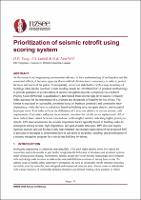Prioritization of seismic retrofit using scoring system

Download
Date
2020-04-22Authors
Tung, Dorian
Lubell, Adam
Newfield, Grant
Metadata
Show full item recordAbstract
As the research and engineering communities advance in their understanding of earthquakes and the associated effects, it becomes apparent that retrofit of old structures is necessary in order to protect the lives and assets of the public. Consequently, owners or stakeholders with a large inventory of buildings often ask the question: which building should be retrofitted first? A practical methodology to provide guidance on prioritization of seismic mitigation projects is proposed via a Retrofit Priority Score (RPS) that is quantitatively determined from several high-level indices. Criticality index accounts for the importance of a structure and the people affected by its loss of use. The former is measured by acceptable downtime based on business continuity and community inter-dependency, while the latter is calculated based on building area, occupant density, and occupied hours per week. Risk index reflects the deficiency of a structure relative to current seismic code requirements. Cost index addresses the economic incentive for retrofit versus replacement. All of these indices have values between zero and one, with a higher number indicating higher priority to retrofit. RPS also incorporates the seismic importance factor typically found in building codes to distinguish among normal, high-importance, and post-disaster structures. RPS does not require rigorous analysis and can be practically implemented. An example application of the proposed RPS is provided in the paper to demonstrate how it can assist in the policy, funding, and prioritization of a seismic mitigation program for a mixed-use building inventory.
